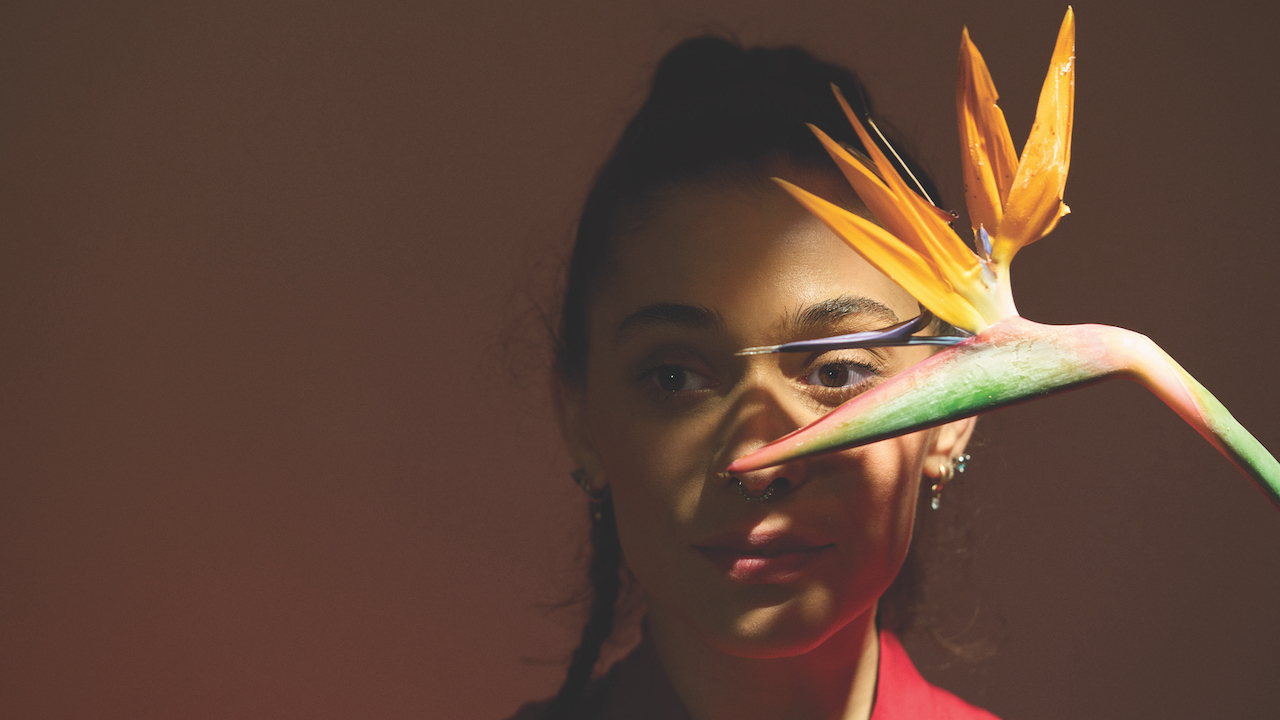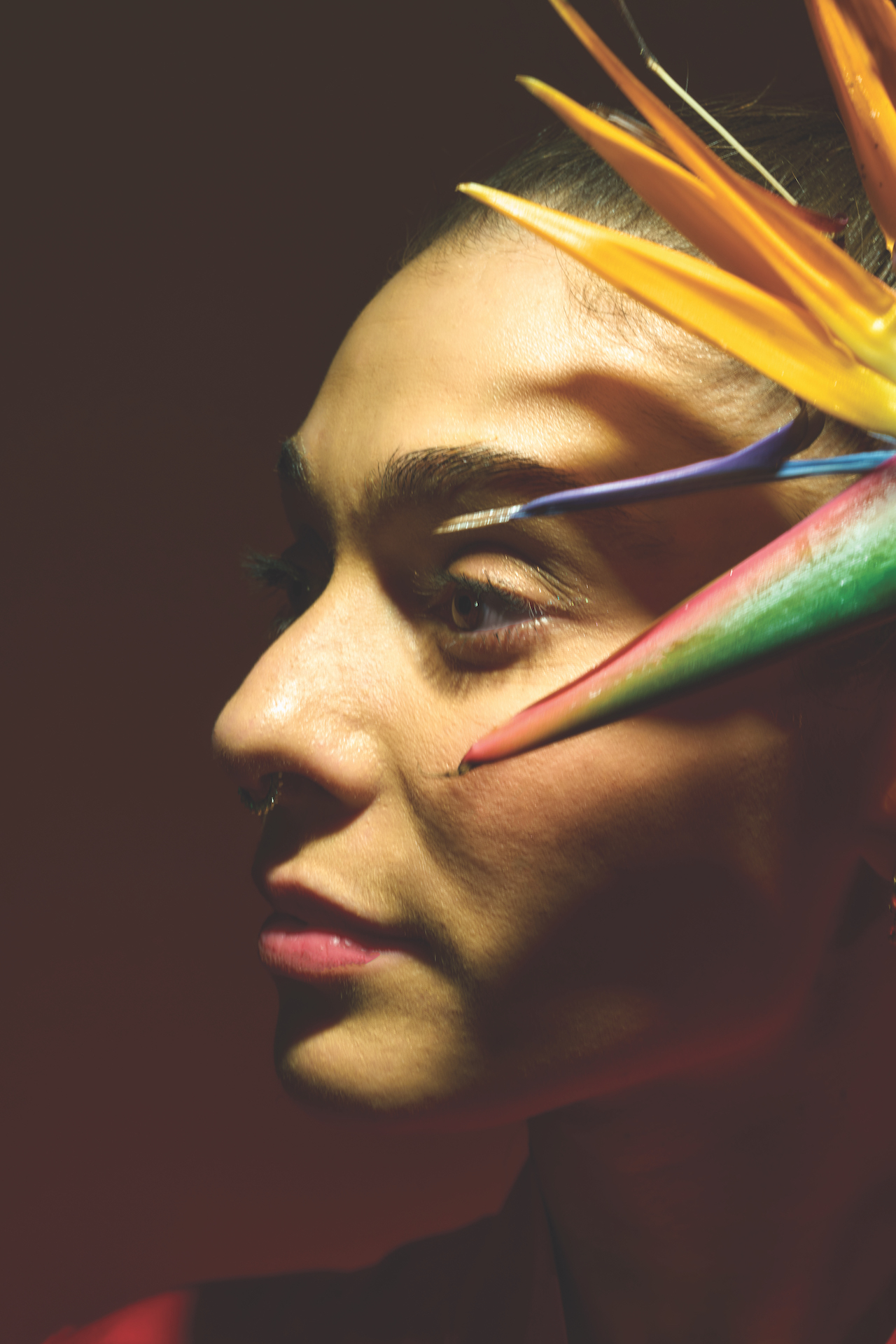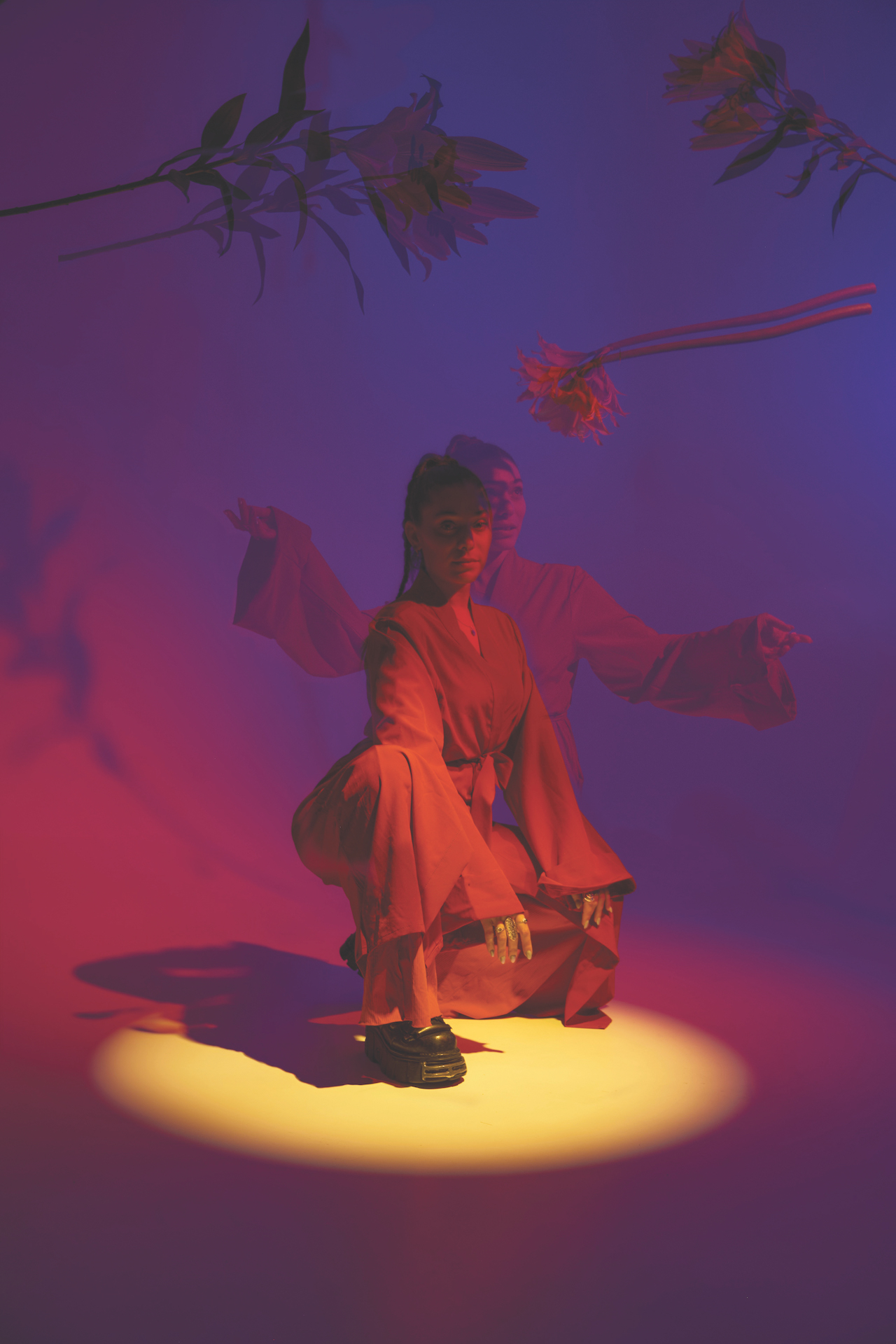
Berlin-based producer Giulia Fournier-Mercadante, aka GiGi FM, practised ballet at the highest level, studying in New York during her teenage years before relocating to London after her dance career was unfortunately cut short.
Introduced to DJing by housemates, it wasn’t long before GiGi FM became a fixture on South London’s close-knit dance music scene, initially a fixture at revered Make Me DJ collective parties prior to residencies at Berghain, Boiler Room and NTS Radio.
In tandem with her successful foray into DJing, GiGi FM began using Ableton, debuting in late 2021 with the ethereal-sounding Kiwi Synthesis Diary 21k EP. Further releases, including her latest Movimiento, have shifted further into the realm of techno, using sound, colour and movement to create pulsating inter-dimensional club music.
While GiGi FM continues to evolve, her longstanding fascination for adopting various body motion technologies to make music by movement increasingly permeates her approach to production.
Tell us about your journey from dance to music.
“I started dancing and playing the piano at a very young age. When I was seven or eight, I learned ballet at the conservatoire and thought, woah, these girls have great tutus, I really want one [laughs]. So I started pursuing dancing more professionally and ended up at the Paris Opera School, which was very prestigious. When I was 11 years old, I started thinking that although I loved dancing to the music what if I could make music by dancing? Then I thought, hmm, maybe I’m watching too much Star Trek!”
What was your next step to making music through dance?
“From the Paris Opera School I went to the Conservatoire National Supérieur in Paris, but wanted to travel the world and ended up gaining a scholarship for a summer intensive course at the School of American Ballet in New York. In NYC I discovered Alvin Ailey, who was the first Afro American dancer to build his own company and dance school.
“I totally fell in love with his approach and got accepted into that school, but when I finished my studies I injured my knee and couldn’t dance anymore. Looking back, despite the disappointment, I feel like that was my destiny. It led me to where I am today and gave me the opportunity to explore my childhood dream of making music with my dancing.”

How did you end up in London?
“I was 19 when I was told I couldn’t dance anymore and ended up working in luxury marketing fragrance at LVMH in Paris, but I missed speaking English on a daily basis so I thought I’d give London a chance and chance took me to a job at Selfridges and Harrods. I never lost my passion for music and dance. While I was working at Harrods, I’d write lyrics, hum melodies into my phone and was going to the gym to try to re-educate my knee and body to start dancing again.
“One night I went to see Fierce Ruling Diva live at Rye Wax in South London, met this girl and told her about my dream to make music by dancing. She worked at Ableton and suggested I come into their office as they’d just created an Early Bird project and were looking for people who’d never used Ableton before. That’s how I started my musical journey.”
Were you DJing at that point?
Ableton is my emotional puke bag! It’s definitely the best creative outlet for me
“I started working at the Rye Wax record shop in Peckham, which has closed now, and found myself surrounded by DJs there. My housemate at the time had just bought CDJs and his girlfriend, Lily, introduced me to Rekordbox and suggested I start DJing instead of asking for the aux cable at the afterparties. I was lucky to be in a household where every morning I could practise DJing and fell in love with using CDJs and learning how to loop, edit and create new music on the spot from other people’s music. I also saw a similarity between the looping function on CDJs and Ableton’s loop-based session view.”
Looking at the timeline of your releases, we’re guessing the pandemic fell into that period and perhaps gave you the time to fully focus on production?
“Like many producers and a lot of FLINTA ones I’ve spoken to, from the time I first touched Ableton and got comfortable with the software I went on an inner journey of not really believing in myself. I made a lot of music before the pandemic but wasn’t totally satisfied with the sound I was getting out of myself. Covid definitely gave me time to pause and approach Ableton in a different way.
“I started using the software as a journal and felt I could take voice notes or video recordings to capture moments and create anything out of them. In retrospect, maybe my initial hesitancy was a good thing because, like dancing, it takes a while to learn your craft and technique in order to be liberated from it and take ownership. I wanted to find my own sound and be happy with the quality of the music before releasing something.”
Your first EP, Kiwi Synthesis Diary 21k, is very atmospheric and underground – almost soundtrack in places. Was it a reflection of your emotions at the time?
“It’s my diary of 2021 and has a lot of voice notes taken from myself and my friends. A lot of the textures were made by taking audio from videos, capturing moments and using granular synthesis to turn them into textures, drums and instruments. The EP is very much a meditational soundscape and a diary of both my struggles and happy moments from that period of time.”
Three or four months later you released the Magnetite EP, which we understand employed some type of gesture control technology to make the music with?
I started thinking, what if I could make music by dancing? Then I thought, hmm, maybe I’m watching too much Star Trek!
“The title of the first song on the Magnetite EP, Senstronaut (MYO), is a word I made up because the track was made by my body using an arm-band motion sensor. I basically danced every single instrument and then layered them on top of each other.”
Is the motion sensor technology similar to that used by Imogen Heap?
“Imogen Heap uses the Mi.Mu Glove, where part of your finger is assigned to a MIDI or audio effects rack and she can basically control her voice or instruments with her hands. The Mi.Mu Glove is cute but it’s narrowing because it’s only a glove and I want to use my whole body. As mentioned earlier, my dream since I was 11 years old is to make music by movement and dancing and the Magnetite EP was my first step in releasing that type of music into the world.”

What specific technologies did you use to help make the Senstronaut track?
“I used a Myo Gesture Control Armband, which basically grabs muscle contractures and the position of your arm in space and sends messages via Bluetooth to Ableton via a Max MSP patch so I can assign any instrument and play it that way. It’s a very cool tool but it’s been discontinued now and it’s not a very stable technology.
Senstronaut was made by my body using an arm-band motion sensor. I basically danced every single instrument and then layered them
“I’ve also worked with Kinect Gesture Recognition technology in the past, which is super fun, but the latency is crazy and it’s not great for live performance accuracy, which is what I’m aiming for. At the moment, I’m working with other full body motion sensors for making music. The project is already born and called GEM, which stands for Gestural Electronic Music. It’s my baby, but I don’t want to give away too much at this point.”
Tell us about your latest EP, Movimiento, the title of which sounds related to movement and momentum…
“Bingo – it literally means ‘movement’. Musically, it’s based on my upbringing and what my parents’ house used to be like on a Sunday morning. They always used to wake me up by opening my bedroom door and playing super-loud salsa, jazz or post-punk music, and with this EP I wanted to give homage to my former dancer self and musical origins. In making the music, I wanted to investigate how to catch movement and layer it within the sonic realm.”
The opening track Gabriella is very expressive and has some wonderful keys – is that your handiwork?
“Yes, I’m playing piano on that track and although there were quite a few takes I was very proud that I could execute a style of music that I’d wanted to make for a long time. I guess it’s not really for me to say, but I think Movimiento can be listened to anywhere. The music is not only for clubs, but tracks like Gabriella are a bridge between techno, jazz and house.”
Percussion is a key feature of your sound and it doesn’t surprise us, for example, that you have an interest in Indian jazz. Are some of those more exotic percussion sounds infused into your music?
“I appreciate polyrhythmic sounds and rhythms and have a lot of love for instruments like the tabla, darabuka and frame drum, which have so much depth. I don’t know if you’ve heard of Mohammad Reza Mortazavi, but he’s an amazing drum player from Iran and what he can do with any drum is mesmerising. I grew up listening to my parents’ love for old Indian, Egyptian, Lebanese and Neapolitan rhythms.
Every time I open Ableton, I just go by intuition, set a bpm, whack an Operator on a MIDI channel and create some weird experiments
“For my own percussion, I like to take lots of different samples and put them into Ableton’s drum rack so I can use a computer, piano or Ableton Push as MIDI controllers and play lots of rolls and single shots as if I’m playing real drums. If I can do this with my body using my motion sensors too, then the creative process feels so much more alive.”

“Although it might not be obvious, I do use my voice a lot in my productions. Sometimes I’ll make pads by singing really long notes with added reverb and other effects, and I like using a really cool tool called Dubler 2 for when I want to quickly lay down a melody that’s inside my head. What’s amazing with Du is that you can just open a MIDI channel, choose your instrument or MIDI and sing your melody straight in.”
“I always start a track by thinking about a movement, a shape and colours. To me, music captures a moment in time and makes it present forever, so the environment and characters are important. For example, I might want to create a blue and orange track, or red with a bit of purple or something that’s shape is round, spiky or floaty. It’s important to set the ground right to tell the story and then I’ll think about the character or message I want to portray to help contextualise those feelings. I hope that makes sense.”
Does that mean your DAW sessions look a little different in terms of how you might move colours around the screen?
“Most of the time I don’t care about the appearance of my MIDI or audio channels on screen, it’s more about what’s in my mind and trying to move the creative process along as quickly as possible. I’m ADHD, so it’s often about creating a note or putting into position the sound elements that need to be there. Ableton is my emotional puke bag [laughs]. It’s definitely the best creative outlet for me and I love the freedom the software gives me to be able to make music anywhere.”
Do you have any other gear?
“Apart from my MIDI keyboards, I have a Nord Lead 2 synthesiser, which I really love, Ableton Push and a Crystallizer pedal from Eventide. Sometimes I’ll go to my friend’s house and hijack their modular gear for a hot minute, but I have enough on my hands with the motion sensors to be diving into other types of hardware. My hardware is my body, so I’m trying to focus on that.”

Do you mix in the box too?
“I don’t have a proper studio and my home is very small, so I don’t really have space for much gear. Less is more and I’ve really found my workflow in the box now. I’m that friend that goes and hijacks other people’s gear and that usually works out quite well.
“For me, the mixdown process is super important. I try my hardest to do as much as possible in the DAW, but feel that mixing and mastering is a different art form to production. I’ve learned a lot of the basics and implemented them into my productions, but prefer to sit down with a mix or mastering engineer who has expertise while ensuring I still have creative direction of the mixdown process.”
You mentioned GEM earlier. When do you think you’ll be releasing new material based on what you call Gestural Electronic Music?
“The time for me to show more about GEM is coming and I’m very excited about that, but right now I’m focused on my label Sea~rène and exploring my different musical faces. In the future, I’d like to do some sort of hybrid live performance but I’m taking each step as it comes. There are so many things that I want to do and I don’t want to put any barriers on them”.
GiGi FM’s latest EP, Movimiento, is out on June 7 via Sea~rène. For more information, visit her Bandcamp page.







